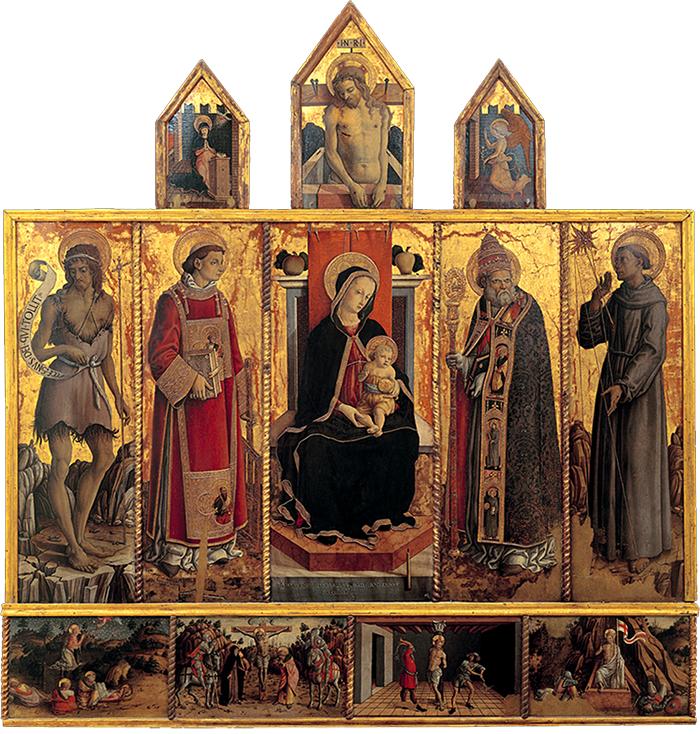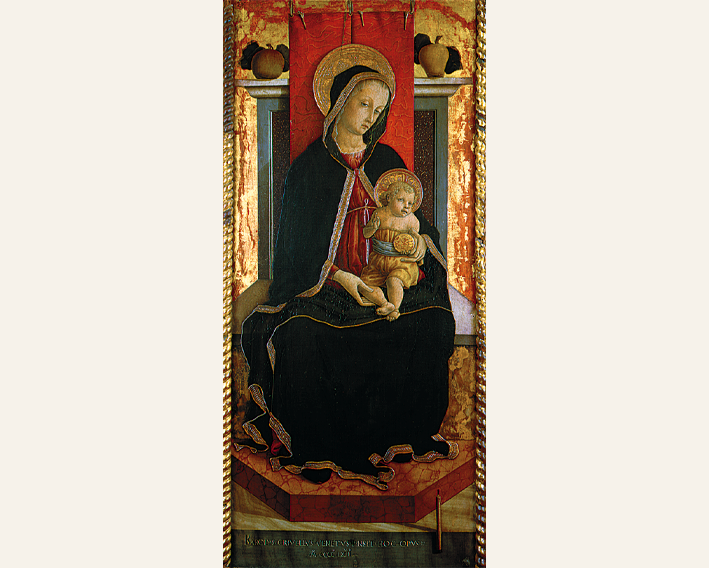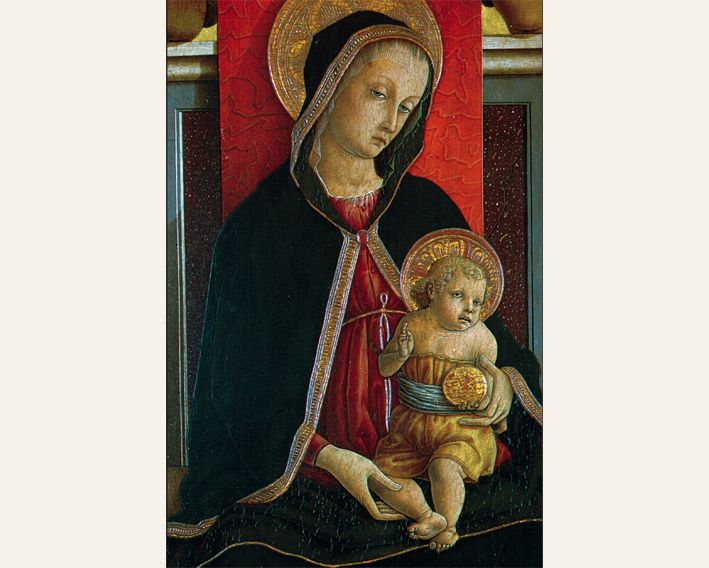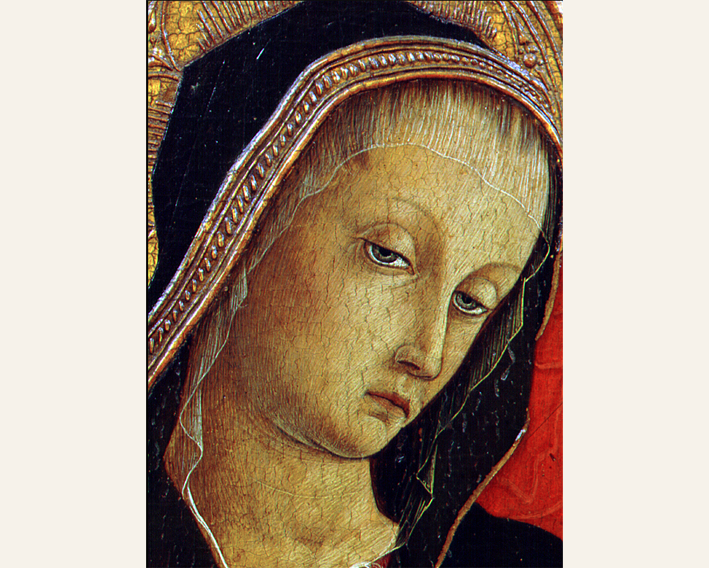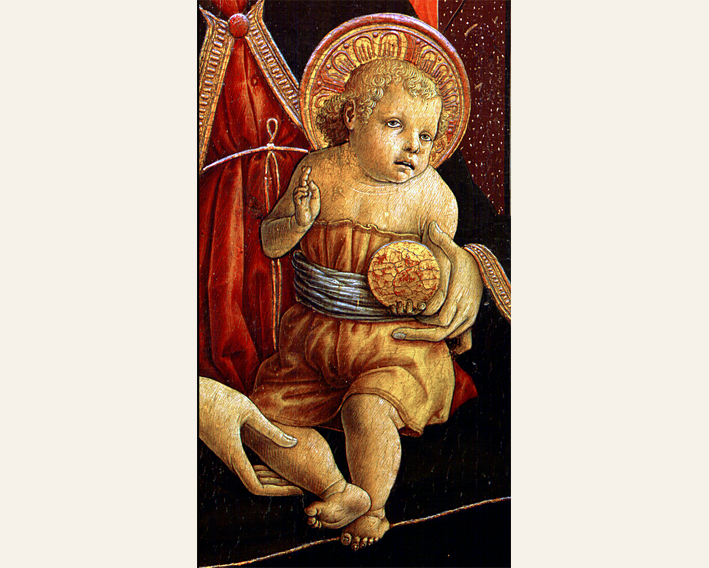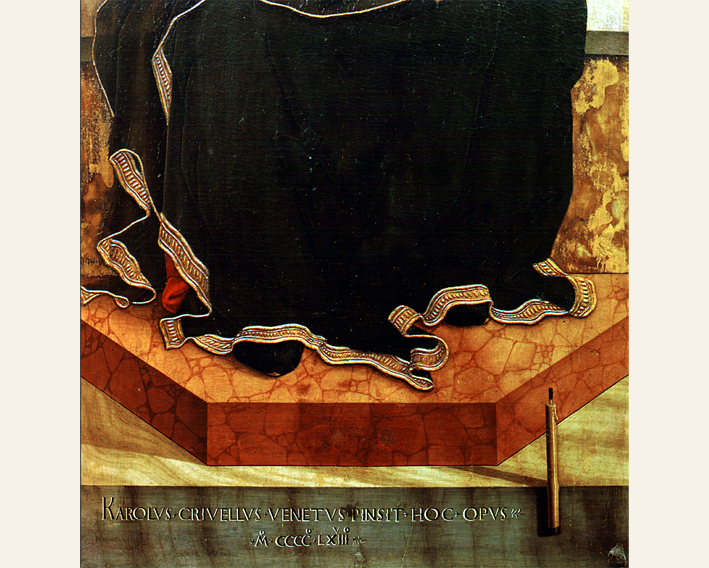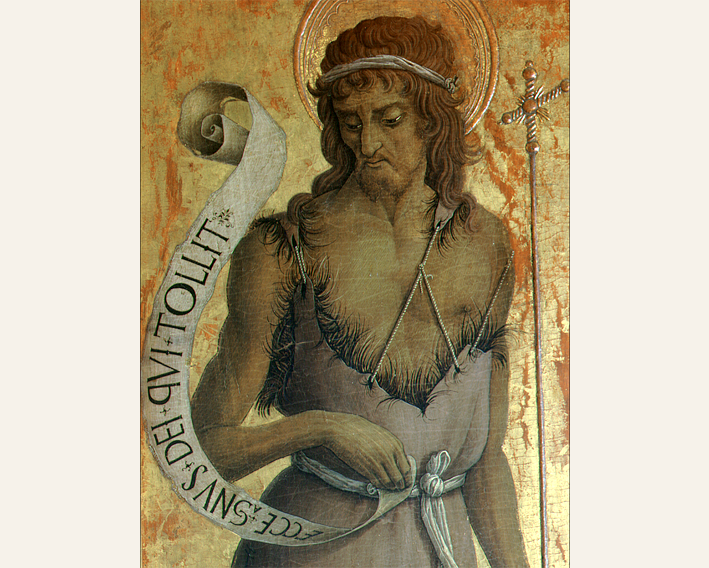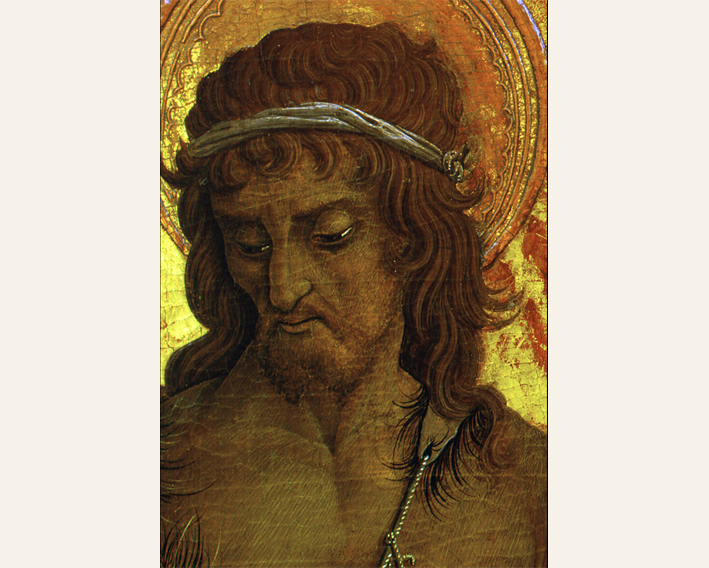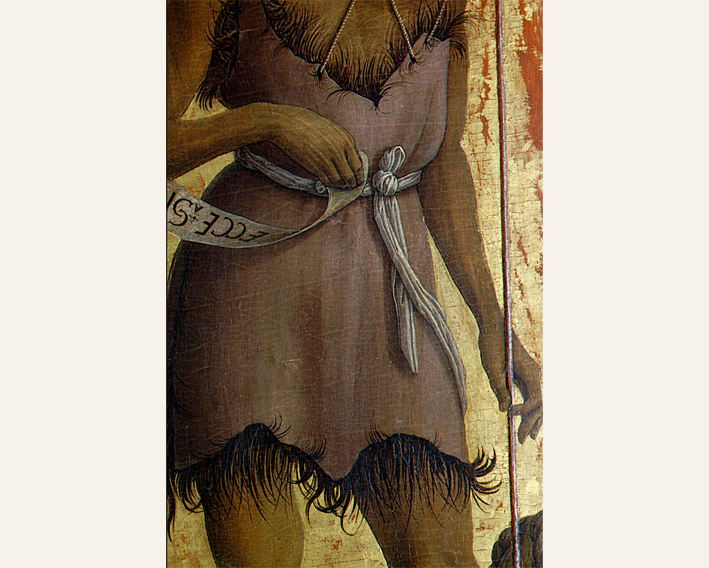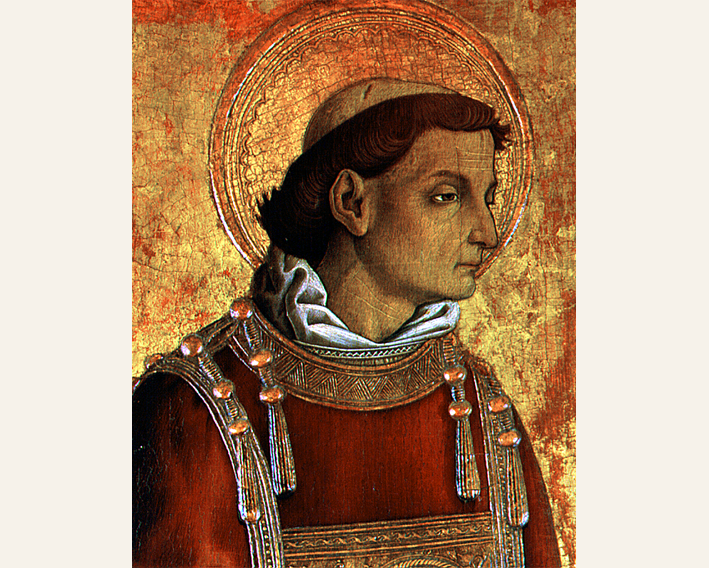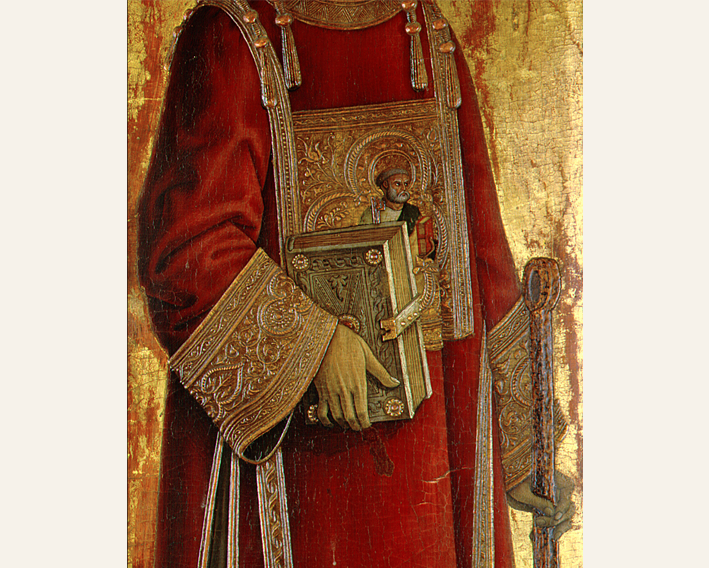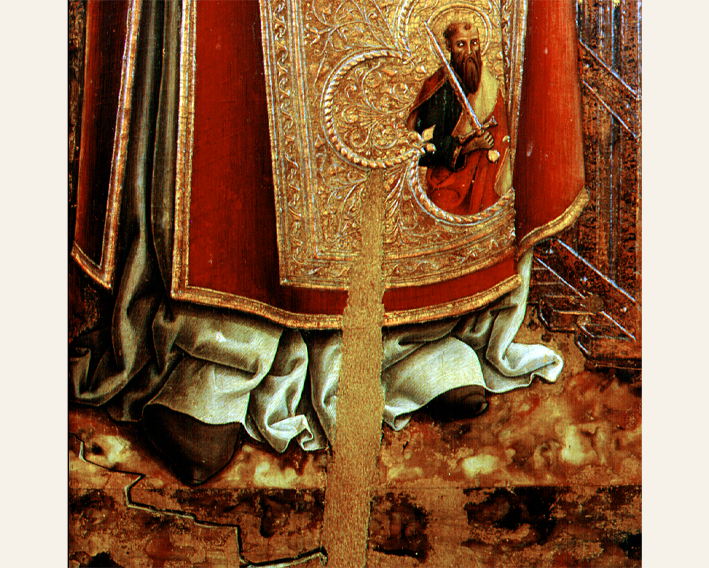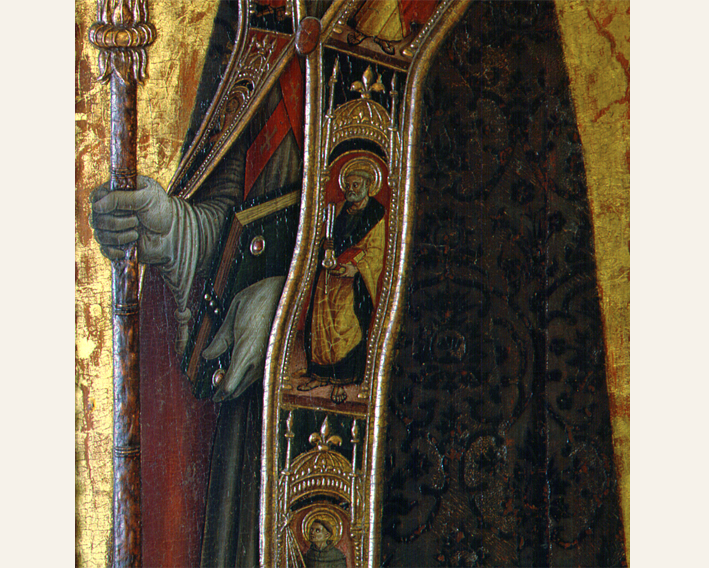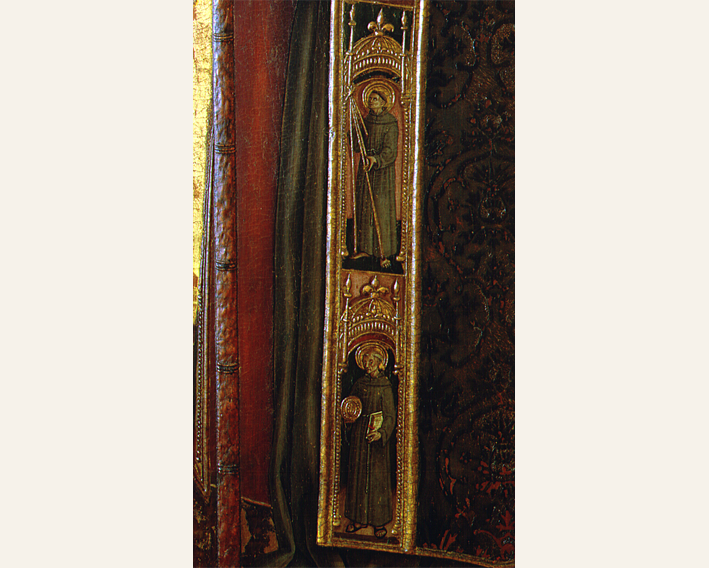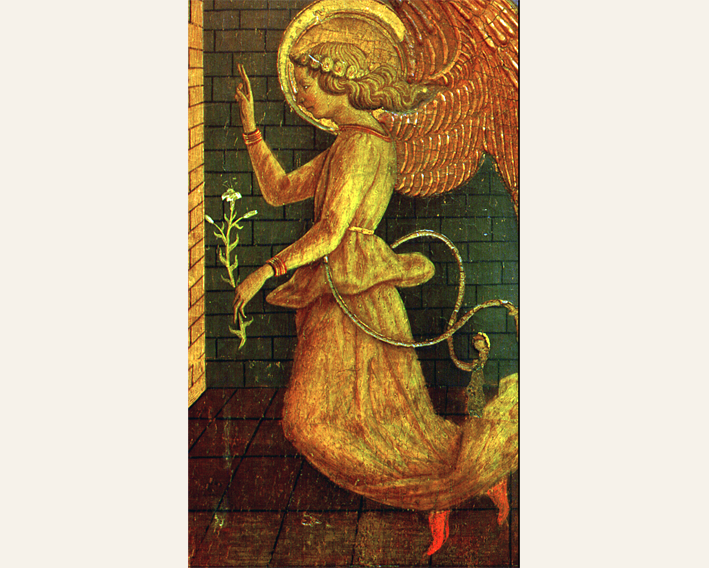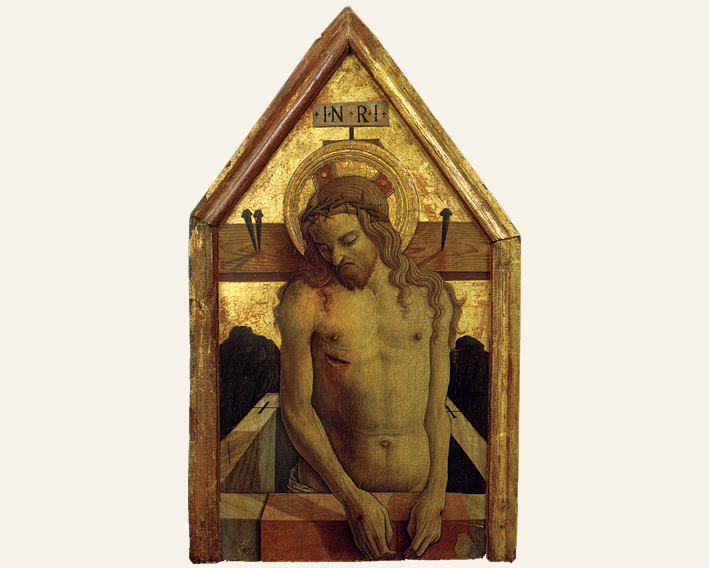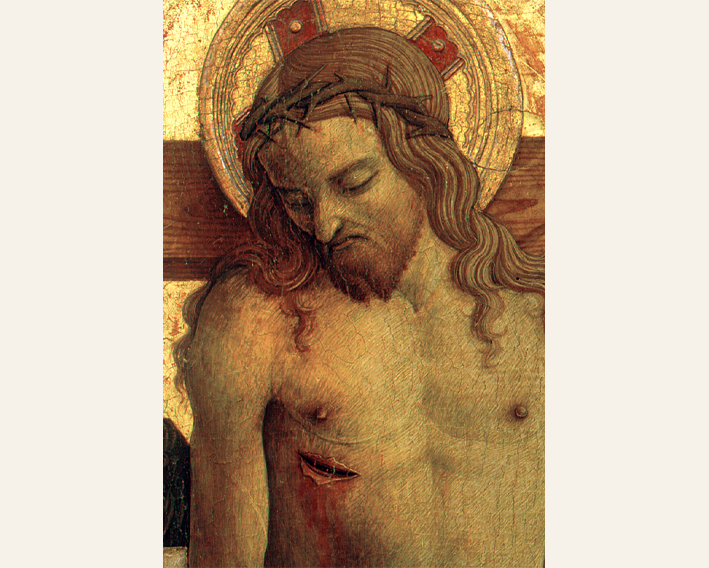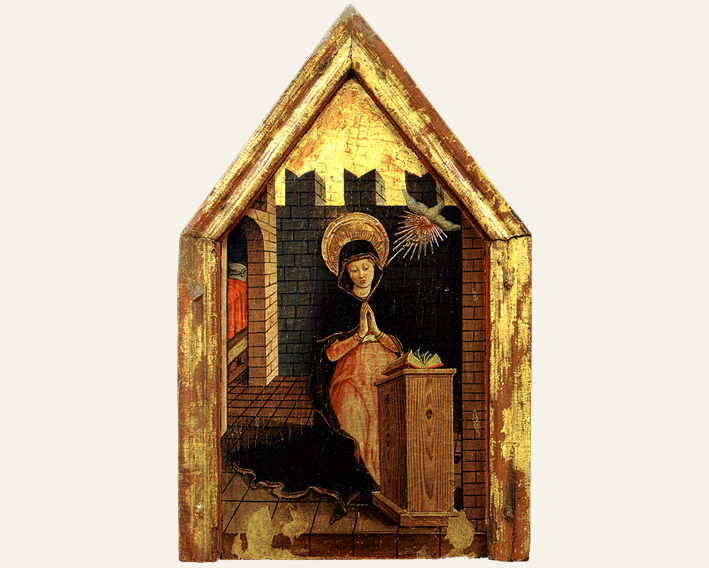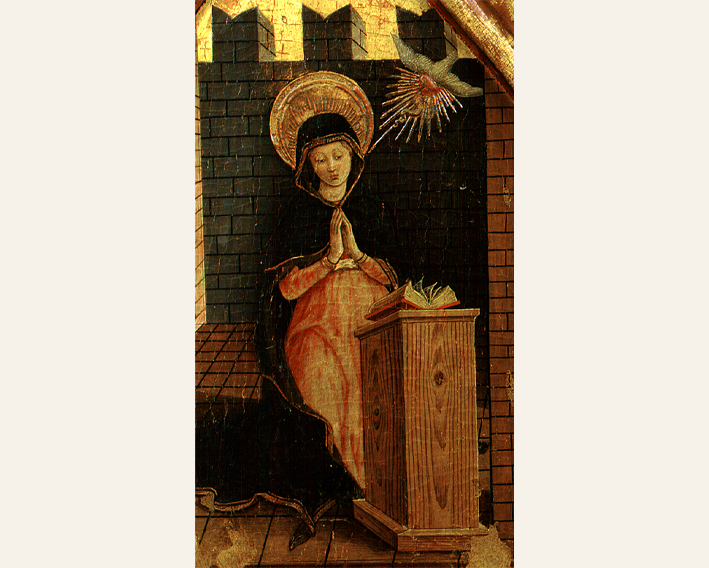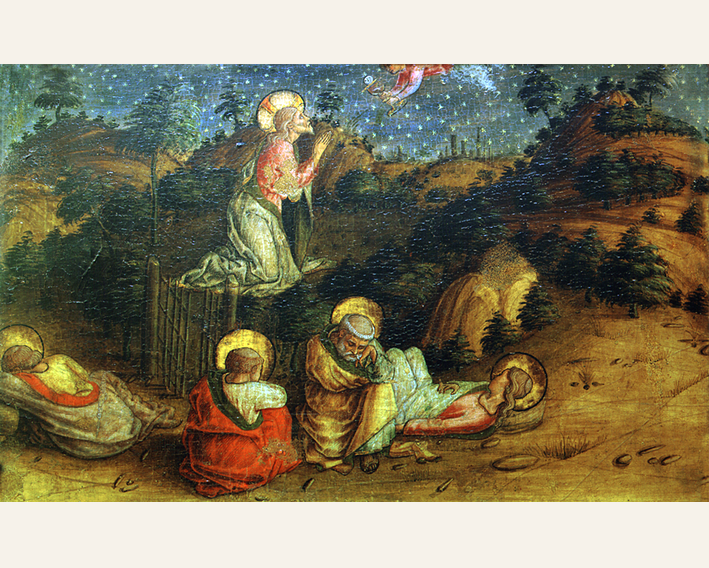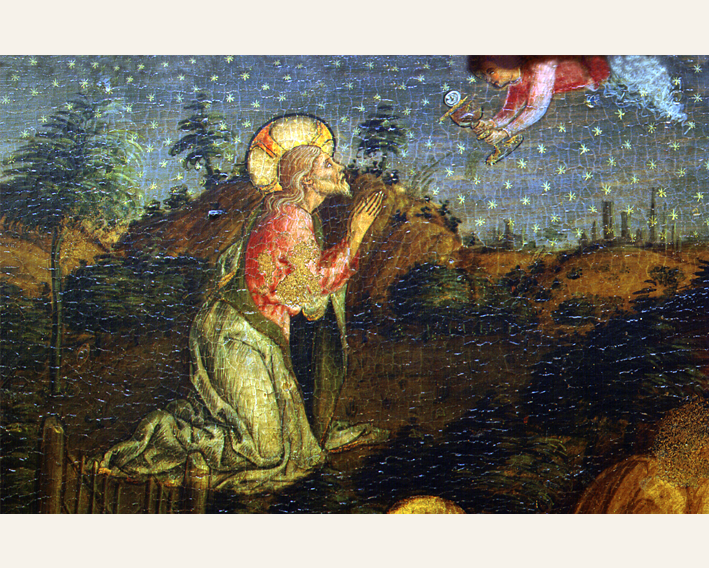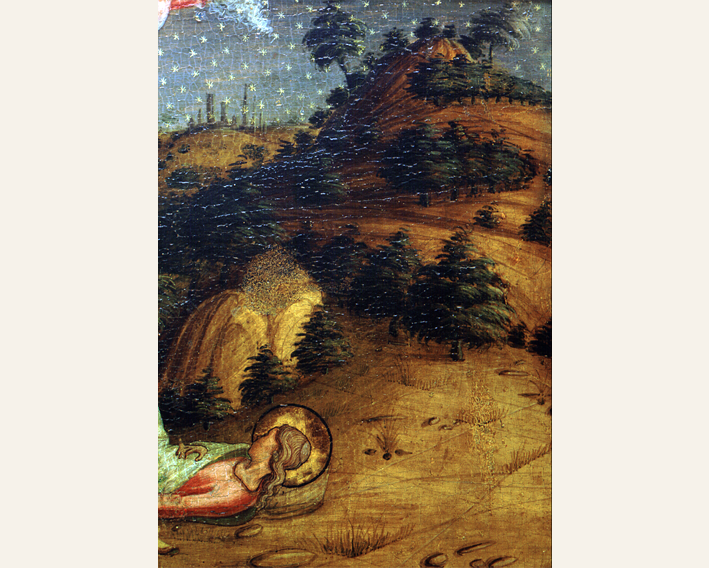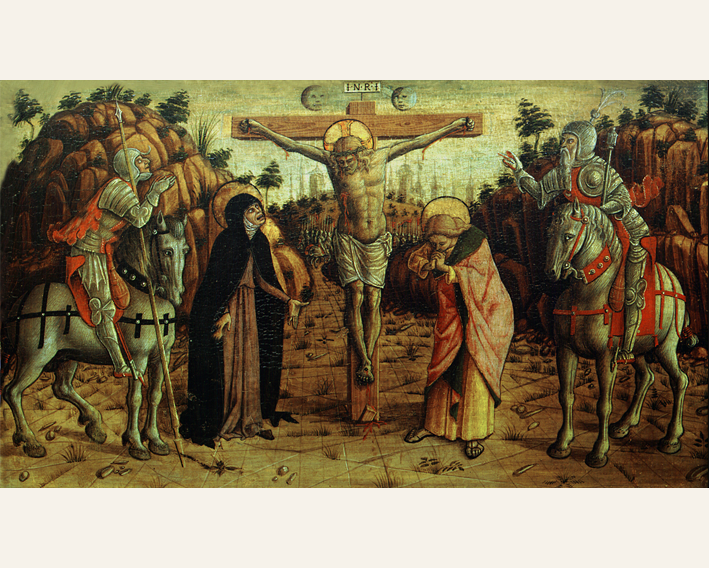Polyptych of Massa Fermana
The polyptych was created by Carlo Crivelli in 1468 for the church of Saints Lorenzo and Silvestro in Massa Fermana. The signature and date are engraved on the lower step of the central panel: “KAROLVS CRIVELLVS VENETVS PINXIT HOC OPVS / MCCCCLXVIII.”
The first document attesting to Carlo's presence in the Marche region dates back to 1468, noting the payment of two ducats to Maestro Giovanni Germano and our painter. Another document dates to March 24 of the same year, the eve of the Annunciation, when the two artists were paid for painting a Madonna and Child for the Palazzo dei Priori in Fermo. Therefore, Carlo arrived in the Marche region at the beginning of 1468 or in the last months of 1467, after his escape to Zara, and painted the now-lost work in Fermo, followed immediately by the polyptych in Massa Fermana.
The altarpiece consists of a central panel depicting the Madonna and Child seated on a throne, larger than the four side panels. Supporting the weight of the panels is a decorated predella at the base, composed of four scenes. The polyptych is crowned by three cusps, the largest depicting the Pietà at the center, while the Annunciation and the Archangel Gabriel Announcing occupy the sides.
The polyptych no longer has its original frame and was described only by Vincenzo Vitali Brancadoro in 1860, who reported that the five main panels were surmounted by carved arches.
Alessandro Delpriori has emphasized several times – Sarnano 2011 and Ascoli Piceno 2022 – that 1468 was a crucial year for art in the Marche region and the polyptych tradition. Alongside Carlo's polyptych, two other altarpieces were created: Giovanni Boccati for Belforte and Niccolò di Liberatore for Sanseverino Marche.
The work was commissioned from Crivelli by a lay patron named Troili Azzolino, who relied on an observant theologian to choose the scenes for the artist to paint.
The central panel depicts the Madonna seated on a classical-style marble throne, holding the Child on her lap. Behind them hangs a red drape of honor, suspended by ties ending in struts. The Madonna wears a dark blue cloak, probably azurite, which over time has turned to malachite green. The cloak is embellished with a gold border created using a brush-applied plaster technique, also evident in the halos of the main figures. Beneath the cloak, she wears a red dress fastened with small buttons and a fine gold belt.
The Baby Jesus is depicted blessing the viewer while holding a golden sphere. A distinctive feature is the unlit candle next to the artist's signature, a motif later repeated in the Madonna della Candeletta (ca. 1490, Pinacoteca di Brera), part of the Camerino Cathedral polyptych.
The side panels depict Saints John the Baptist, Lawrence, Sylvester, and Francis. Saint John the Baptist is shown in pilgrim’s clothes, set in a desert landscape, with his attributes: a relief processional cross and a scroll inscribed “ECCE AGNUS DEI TOLLIT.”
Next is St. Lawrence, patron saint of Massa Fermana, holding the gridiron of his martyrdom. His red robe, likely painted with cinnabar and enriched with brush-applied plaster, is particularly refined. Within the gilded quatrefoils, Carlo also inserted Saints Peter (with the keys) and Paul (with the sword).
Saint Sylvester, bishop, is depicted in a position of honor, holding a book and a crosier made of raised plaster gilded over silver foil applied on red ochre. This technique once produced luminous effects, now darkened by oxidation. He wears a mitre and a cloak bordered with depictions of Saints Paul, Peter, Francis, and Bernardino of Siena. The cloak itself was crafted entirely of silver with thistle motifs, engraved and hammered to create a play of light and shadow, once striking in candlelight. Today, much of the silver is tarnished, with red bole visible beneath.
The last panel shows St. Francis receiving the stigmata from a seraphic Christ, wearing the Franciscan habit tied with a rope of three knots symbolizing the order’s vows.
All figures are set against a gilded background created with the guazzo technique, applying gold foil on red bolus. The predella includes four equal-sized scenes: the Agony in the Garden, the Crucifixion, the Flagellation, and the Resurrection. The first is a night scene, its sky dotted with star motifs made in shell technique, while the angel’s chalice is applied with the mission technique.
The polyptych is crowned by three cusps: at the center Christ emerges from the tomb, showing his wounds, behind him the cross with nails and the inscription “I N R I.” On one side, the Archangel Gabriel, wings still open, announces the Incarnation; opposite, the Virgin lowers her gaze and joins her hands in prayer. The Annunciation unfolds in a setting resembling a castle, with brick battlements and a golden sky.
The composition recalls Paduan culture, comparable to Francesco Squarcione, Giorgio Schiavone, and Andrea Mantegna. The predella scenes echo Mantegna’s San Zeno polyptych (Padua–Verona, 1460). The reconstruction of the Massa Fermana polyptych was discussed by Delpriori in 2022 at the Birmingham exhibition “Shadow in the Sky”, where he hypothesized the Crucifixion beneath the Madonna and Child, shifting the predella scenes accordingly. Small vertical pillars (5–6 cm wide) likely separated the panels. Thus, one scene—probably a Last Supper under St. John the Baptist—has been lost.
Delpriori (2022) concluded: “In this panel, the painter asserts his training and publishes a text in pure Venetian dialect, with the same references to Schiavone and Mantegna.”
Carlo Crivelli
Polittico di Massa Fermana, 1468
Tempera su tavola
Firmato e datato: KAROLVS CRIVELLVS VENETVS PINXIT HOC OPVS MCCCCLXVIII
Descrizione
Madonna col Bambino, S. Giovanni Battista, S. Lorenzo, S. Silvestro e S. Francesco
Cuspidi: Cristo in Pietà, la Vergine Annunziata e l’Arcangelo Gabriele
Predella: Orazione nell’orto, Crocifissione, Flagellazione, Resurrezione
Dimensioni
Pannello centrale: 105×44 cm
Pannelli laterali: ciascuno 105×34 cm
Cuspide centrale: 51×28 cm
Cuspidi laterali: ciascuno 37×19 cm
Predella: 34×190 cm
Pinacoteca Comunale (già Parrocchiale dei SS. Lorenzo, Silvestro e Ruffino)
Via Giuseppe Garibaldi, 60
Massa Fermana (FM)
Polyptych of Massa Fermana
The polyptych was created by Carlo Crivelli in 1468 for the church of Saints Lorenzo and Silvestro in Massa Fermana. The signature and date are engraved on the lower step of the central panel: “KAROLVS CRIVELLVS VENETVS PINXIT HOC OPVS / MCCCCLXVIII.”
The first document attesting to Carlo's presence in the Marche region dates back to 1468, noting the payment of two ducats to Maestro Giovanni Germano and our painter. Another document dates to March 24 of the same year, the eve of the Annunciation, when the two artists were paid for painting a Madonna and Child for the Palazzo dei Priori in Fermo. Therefore, Carlo arrived in the Marche region at the beginning of 1468 or in the last months of 1467, after his escape to Zara, and painted the now-lost work in Fermo, followed immediately by the polyptych in Massa Fermana.
The altarpiece consists of a central panel depicting the Madonna and Child seated on a throne, larger than the four side panels. Supporting the weight of the panels is a decorated predella at the base, composed of four scenes. The polyptych is crowned by three cusps, the largest depicting the Pietà at the center, while the Annunciation and the Archangel Gabriel Announcing occupy the sides.
The polyptych no longer has its original frame and was described only by Vincenzo Vitali Brancadoro in 1860, who reported that the five main panels were surmounted by carved arches.
Alessandro Delpriori has emphasized several times – Sarnano 2011 and Ascoli Piceno 2022 – that 1468 was a crucial year for art in the Marche region and the polyptych tradition. Alongside Carlo's polyptych, two other altarpieces were created: Giovanni Boccati for Belforte and Niccolò di Liberatore for Sanseverino Marche.
The work was commissioned from Crivelli by a lay patron named Troili Azzolino, who relied on an observant theologian to choose the scenes for the artist to paint.
The central panel depicts the Madonna seated on a classical-style marble throne, holding the Child on her lap. Behind them hangs a red drape of honor, suspended by ties ending in struts. The Madonna wears a dark blue cloak, probably azurite, which over time has turned to malachite green. The cloak is embellished with a gold border created using a brush-applied plaster technique, also evident in the halos of the main figures. Beneath the cloak, she wears a red dress fastened with small buttons and a fine gold belt.
The Baby Jesus is depicted blessing the viewer while holding a golden sphere. A distinctive feature is the unlit candle next to the artist's signature, a motif later repeated in the Madonna della Candeletta (ca. 1490, Pinacoteca di Brera), part of the Camerino Cathedral polyptych.
The side panels depict Saints John the Baptist, Lawrence, Sylvester, and Francis. Saint John the Baptist is shown in pilgrim’s clothes, set in a desert landscape, with his attributes: a relief processional cross and a scroll inscribed “ECCE AGNUS DEI TOLLIT.”
Next is St. Lawrence, patron saint of Massa Fermana, holding the gridiron of his martyrdom. His red robe, likely painted with cinnabar and enriched with brush-applied plaster, is particularly refined. Within the gilded quatrefoils, Carlo also inserted Saints Peter (with the keys) and Paul (with the sword).
Saint Sylvester, bishop, is depicted in a position of honor, holding a book and a crosier made of raised plaster gilded over silver foil applied on red ochre. This technique once produced luminous effects, now darkened by oxidation. He wears a mitre and a cloak bordered with depictions of Saints Paul, Peter, Francis, and Bernardino of Siena. The cloak itself was crafted entirely of silver with thistle motifs, engraved and hammered to create a play of light and shadow, once striking in candlelight. Today, much of the silver is tarnished, with red bole visible beneath.
The last panel shows St. Francis receiving the stigmata from a seraphic Christ, wearing the Franciscan habit tied with a rope of three knots symbolizing the order’s vows.
All figures are set against a gilded background created with the guazzo technique, applying gold foil on red bolus. The predella includes four equal-sized scenes: the Agony in the Garden, the Crucifixion, the Flagellation, and the Resurrection. The first is a night scene, its sky dotted with star motifs made in shell technique, while the angel’s chalice is applied with the mission technique.
The polyptych is crowned by three cusps: at the center Christ emerges from the tomb, showing his wounds, behind him the cross with nails and the inscription “I N R I.” On one side, the Archangel Gabriel, wings still open, announces the Incarnation; opposite, the Virgin lowers her gaze and joins her hands in prayer. The Annunciation unfolds in a setting resembling a castle, with brick battlements and a golden sky.
The composition recalls Paduan culture, comparable to Francesco Squarcione, Giorgio Schiavone, and Andrea Mantegna. The predella scenes echo Mantegna’s San Zeno polyptych (Padua–Verona, 1460). The reconstruction of the Massa Fermana polyptych was discussed by Delpriori in 2022 at the Birmingham exhibition “Shadow in the Sky”, where he hypothesized the Crucifixion beneath the Madonna and Child, shifting the predella scenes accordingly. Small vertical pillars (5–6 cm wide) likely separated the panels. Thus, one scene—probably a Last Supper under St. John the Baptist—has been lost.
Delpriori (2022) concluded: “In this panel, the painter asserts his training and publishes a text in pure Venetian dialect, with the same references to Schiavone and Mantegna.”

